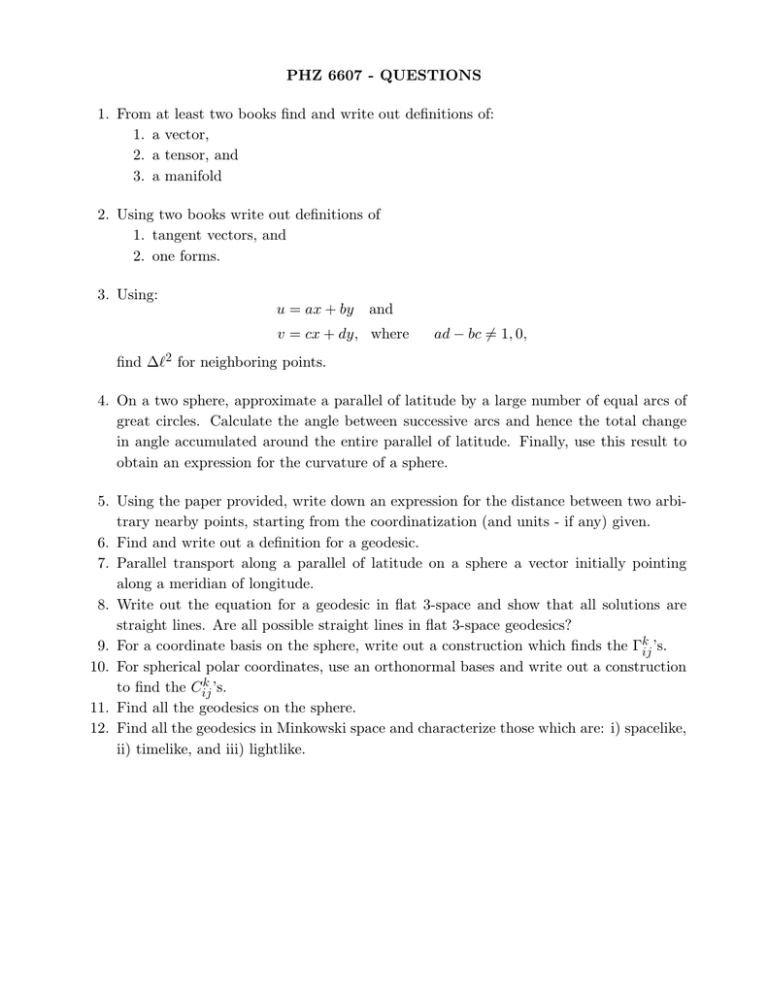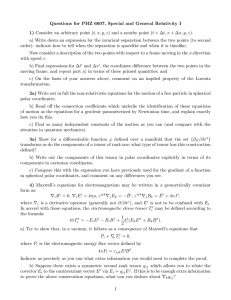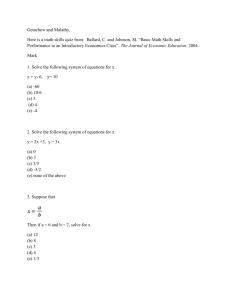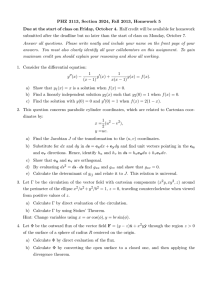PHZ 6607 - QUESTIONS 1. a vector, 2. a tensor, and
advertisement

PHZ 6607 - QUESTIONS
1. From at least two books find and write out definitions of:
1. a vector,
2. a tensor, and
3. a manifold
2. Using two books write out definitions of
1. tangent vectors, and
2. one forms.
3. Using:
u = ax + by
and
v = cx + dy, where
find ∆ℓ2 for neighboring points.
ad − bc 6= 1, 0,
4. On a two sphere, approximate a parallel of latitude by a large number of equal arcs of
great circles. Calculate the angle between successive arcs and hence the total change
in angle accumulated around the entire parallel of latitude. Finally, use this result to
obtain an expression for the curvature of a sphere.
5. Using the paper provided, write down an expression for the distance between two arbitrary nearby points, starting from the coordinatization (and units - if any) given.
6. Find and write out a definition for a geodesic.
7. Parallel transport along a parallel of latitude on a sphere a vector initially pointing
along a meridian of longitude.
8. Write out the equation for a geodesic in flat 3-space and show that all solutions are
straight lines. Are all possible straight lines in flat 3-space geodesics?
9. For a coordinate basis on the sphere, write out a construction which finds the Γkij ’s.
10. For spherical polar coordinates, use an orthonormal bases and write out a construction
k ’s.
to find the Cij
11. Find all the geodesics on the sphere.
12. Find all the geodesics in Minkowski space and characterize those which are: i) spacelike,
ii) timelike, and iii) lightlike.
13. The world line of a particle is described by the parametric equations in some Lorentz
frame
λ
λ
t(λ) = a sinh
,
x(λ) = a cosh
,
a
a
where λ is the parameter and a is a constant. Describe the motion and compute the
particle’s four-velocity and acceleration components. Show that λ is proper time along
the world line and that the acceleration is uniform. Interpret a. (Ex 2.21)
14. For the metric: ds2 = −(1 − rro )dt2 + dr 2 /(1 − rro ) + r 2 dϑ2 + r 2 sin2 ϑdφ2 ,
find the Γα
βν and write out the geodesic equations.
15. Construct and write out the general solution for a geodesic on a sphere by a geometrical
argument.
16. Construct Lx , Ly , Lz , L2 in Minkowski space in Cartesian Coordinates (in terms of q α ’s
and pα ’s) and show that each is conserved.
17. a) Using the Lagrangian
1
£ = mgµν ẋµ ẋν ,
2
in cartesian (spatial) coordinates, find expressions for the conserved linear and angular
canonical momenta px , py , pz , Lx, Ly and Lz , in terms of the ‘velocities’.
b) Similarly, starting with the Lagrangian written in spherical polar coordinates, find
expressions for the canonical momenta pr , pθ and pφ in terms of the ‘velocities’
which arise for these coordinates.
c) Use the coordinate relations:
x = rsinθcosφ,
y = rsinθsinφ and,
z = rcosφ
write down the relations giving the cartesian velocities in terms of the polar velocities.
d) Hence, obtain expressions for all the conserved momenta listed in part a) in terms
of the canonical momenta for polar coordinates.
e) What type of tensor are the velocities and what type the momenta? (This difference explains why it is dangerous to go directly from the velocities in one set
of coordinates to the momenta in another. It also explains why p · ẋ is always a
scalar.)
18. Consider the four-dimensional spacetime metric which in {t, r, θ, φ} coordinates has di
agonal components −(1 − rs /r), 1/(1 − rs /r), r 2, r 2sin2 θ , all other components being
zero. Notice that in the usual sense, the parameter rs has the dimensions of length.
a) Write out expressions for the canonical momenta of a particle whose Lagrangian
is given by:
1
£ = mgµν ẋµ ẋν , in which . = d/dλ,
2
2
in which the spacetime geometry is given by this metric.
b) Write out Hamilton’s equations of motion for this particle, and indicate which
canonical momenta are conserved.
c) By explicit calculation, show that all components of the angular momentum which
were defined in Question 16) are in fact conserved for the particle moving in this
non-flat geometry. Hence, or otherwise, argue whether or not this spacetime is
spherically symmetric.
d) Find an expression for dr/dφ, assuming the motion takes place in the equatorial
plane. Obtain the corresponding equation for a particle of mass m moving under
Newtonian gravity around a central body of mass M .
e) Using your knowledge of the difference between Newtonian physics and relativistic
physics, and by assuming that the motion takes place in a region where both |v|/c
the ratio rs /r are small, indicate how the resulting motion in this spacetime can be
compared with motion in a Newtonian gravitational potential, and find the implied
correspondence between the parameter rs and the mass causing the potential: if
you have used c = 1, restore it in the final relation you obtain.
19. A clock is in a circular orbit at r = 10 M in a Schwarzschild metric.
a) How much time elapses on the clock during one orbit? (Integrate the proper time
dτ = |ds2 |1/2 over an orbit.)
b) It sends out a signal to a distant observer once each orbit. What time interval
does the distant observer measure between receiving any two signals?
c) A second clock is located at rest at r = 10 M next to the orbit of the first clock.
(Rockets keep it there.) How much time elapses on it between successive passes of
the orbiting clock?
d) Calculate (b) again in seconds for an orbit at r = 6 M where M = 14M⊙ . This
is the minimum fluctuation time one expects in the X-ray spectrum of Cyg X-1:
why?
e) If the orbiting “clock” is the twin Artemis, in the orbit in (d), how much does she
age during the time her twin Diana lives 40 years far from the black hole and at
rest with respect to it? (ex 11.7)
20. Consider the x − t plane of an inertial observer in SR. A certain uniformly accelerated
observer wishes to set up an orthonormal coordinate system. By Question 13, his world
line is
t(λ) = a sinh λ,
x(λ) = a cosh λ,
where a is a constant and aλ is his proper time (clock time on his wrist watch).
a) Show that the spacelike line described by the equation above with a as the variable parameter and λ fixed is orthogonal to his world line where they intersect.
Changing λ in the equation above then generates a family of such lines.
b) Show that this equation defines a transformation from coordinates (t, x) to coordinates (λ, a) which form an orthogonal coordinate system. Draw these coordinates
3
and show that they cover only one half of the original t − x plane. Show that
the coordinates are bad on the lines |x| = |t|, so they really cover two disjoint
quadrants.
c) Find the metric tensor and all the Christoffel symbols in this coordinate system.
This observer will do a perfectly good job provided that he always uses Christoffel symbols appropriately and sticks to events in his quadrant. In this sense, SR
admits accelerated observers. The right-hand quadrant in these coordinates is
sometimes called Rindler space, and the boundary lines x = ±t bear some resemblance to the black-hole horizons we will study later. (Ex 5.21)
21. Take the flat Minkowski metric in cartesian coordinates. Find all vectors ~v such that
£~v g = 0.
22. a) From the equation:
1
Rαβµν ≡ gαλ Rλ βµν =
gαν,βµ − gαµ,βν + gβµ,αν − gβν,αµ ,
2
for the Riemann tensor in locally Minkowsi coordinates, verify the following identities:
•
•
Rαβµν = −Rβαµν = −Rαβνµ = Rµναβ ,
Rαβµν + Rανβµ + Rαµνβ = 0.
(Ex 6.18)
b) Show that the first set of equalities reduces the number of independent components
of Rαβµν from 4×4×4×4 = 256 to 6×7/2 = 21. Hint: treat pairs of indices.
Calculate how many independent choices of pairs there are for the first and the
second pairs on Rαβµν .)
c) Show that the second equation imposes only one further relation independent of
those already established on the components, reducing the total of independent
ones to 20.
23. In an inertial frame O calculate the components of the stress-energy tensors of the
following systems:
a) A group of particles all moving with the same velocity v = βex , as seen in O.
Let the rest-mass density of these particles be ρ0 , as measured in their comoving
frame. Assume a sufficiently high density of particles to enable treating them as
a continuum.
b) A ring of N similar particles of mass m rotating counter-clockwise in the x − y
plane about the origin of O, at a radius a from this point, with an angular velocity
ω. The ring is a torus of circular cross-section of radius δa≪a, within which the
particles are uniformly distributed with a high enough density for the continuum
approximation to apply. Do not include the stress-energy of whatever forces keep
them in orbit. (Part of the calculation will relate ρ0 of part (a) to N, a, ω, and
δa.)
c) Two such rings of particles, one rotating clockwise and the other counter-clockwise,
at the same radius a. The particles do not collide or intereact in any way. (Ex
4.21)
4
24. Suppose that in some coordinate system the components of the metric gαβ are independent of some coordinate xµ .
a) Show that the conservation law T ν µ;ν = 0 for any stress-energy tensor becomes
√
√
1
− gTµν ,ν = 0.
−g
b) Suppose that in these coordinates T αβ 6= 0 only in some bounded region of each
spacelike hypersurface x0 = const. Show that Eq. (7.41) implies
Z
√
Tµν − g nν d3 x
x0 =const.
is independent of x0 , if nν is the unit normal to the hypersurface. This is the
generalization to continua of a conservation law known for geodesic motion.
c) Consider flat Minkowski space in a global inertial frame with spherical polar coordinates (t, r, θ, φ). Show from (b) that
Z
J=
Tφ0 r 2 sin θ dr dθ dφ
t=const.
is independent of t. This is the total angular momentum of the system.
d) Express the integral in (c) in terms of the components of T αβ on the Cartesian
basis (t, x, y, z), showing that
Z
J=
(xT y0 − yT x0 )dx dy dz.
This is the continuum version of the nonrelativistic expression (r × p)z for a particles angular momentum about the z axis. (Ex 7.8)
25. Consider a particle constrained to more on the surface of a sphere. Starting from a Lagrangian formulation find the Hamiltonian for the system, and derive all the constraints.
26. Electromagnestism in SR. (This exercise is suitable only for students who have already
encountered Maxwell’s equation in some form.) Maxwell’s equations for the electric and
magnetic fields in vacuum, E and B, in three-vector notation are
∂
E = 4πJ,
∂t
∂
∇ × E + B = 0,
∂t
∇ · E = 4πρ,
∇×B−
∇ · B = 0,
in units where µ0 = ε0 = c = 1. (Here ρ is the density of electric charge and J the
current density.)
a) An antisymmetric tensor F can be defined on spacetime by the equations F 0i =
E i (i = 1, 2, 3), F xy = B z , F xz = B x , F zx = B y . Find from this definition all other
components F µν in this frame and write them down in a matrix.
5
b) A rotation by an angle θ about the z axis is one kind of Lorentz transformation,
with the matrix
1
0
0
0
0 cos θ −sin θ 0
Λβ′ α =
.
0 sin θ
cos θ 0
0
0
0
1
Show that the new components of F, F α′β′ = Λα′ µ Λβ′ ν F µν , define new electric
and magnetic three-vector components (by the rule given in (a)) that are just the
same as the components of the old E and B in the rotated three-space. (This
shows that a spatial rotation of F makes a spatial rotation of E and B.)
c) Define the current four-vector J~ by J 0 = ρ, J i = (J)i , and show that two of
Maxwell’s equations are just
F µν ,ν = 4πJ µ .
d) Show that the other two of Maxwell’s equations are Fµν,λ + Fνλ,µ + Fλµ,ν = 0.
Note that there are only four independent equations here. That is, choose one
index value, say 0. Then the three other values (1,2,3) can be assigned to µ, ν, λ
in any order, producing the same equation (up to an overall sign) each time. Try
it and see: it follows from antisymmetry of Fµν .
e) We have now expressed Maxwell’s equations in tensor form. Show that conservaµ
~ ),
tion of charge, Jµ = 0 (recall the similar equation for the number-flux vector N
is implied by (the equation in c). (Hint: use antisymmetry of Fµν .)
f) The charge density in any frame is J 0 . Therefore the total charge in spacetime
R 0
is Q =
J dxdydz, where the integral extends over an entire hypersurface t =
˜ = ñ a unit normal for this hypersurface, show that
const. Defining dt
Z
Q=
J α nα dx dy dz.
g) Use Gauss’ law and part c to show that the total charge enclosed within any
closed two-surface L in the hypersurface t = const. can be determined by doing
an integral over L itself:
I
I
0i
Q=
F ni dL =
E · ndL,
S
S
where n is the unit normal to L in the hypersurface (not the same as ñ in part (f)
above).
h) Perform a Lorentz transformation on F µν to a frame Ō moving with velocity ν
in the x direction relative to the frame used in (a) above. In this frame define a
three-vector Ē with components Ē i = F 0̄ī , and similarly for B̄ in analogy with
(a). In this way discover how E and B behave under a Lorentz transformation:
they get mixed together! Thus, E and B themselves are not Lorentz invariant,
but are merely components of F, called the Faraday tensor, which is the invariant
6
27. Find
a)
b)
28. Find
description of electromagnetic fields in relativity. If you think carefully, you will
see that on physical grounds they cannot be invariant. In particular, the magnetic
field is created by moving charges; but a charge moving in one frame may be at rest
in another, so a magnetic field which exists in one frame may not exist in another.
What is the same in all frames is the Faraday tensor; only its components get
transformed. (Ex 4.25)
and write out a definition of:
a static spacetime, and
a stationary spacetime
the coordinate transformation t̂(t, ∼) such that:
ds2 = −(1 −
2M 2
dr 2
)dt +
+ r 2 dΩ2
2M
r
(1 − r )
= −a(r)dt̂2 + 2b(r)dt̂dr + dr 2 + r 2 dΩ2 .
~ · ~p, is the energy the same particle
29. The locally measured energy of a particle, E∗ = −U
would have in SR if it passed the observer with the same speed. If therefore contains
no information about gravity, about the curvature of spacetime. By referring to the
p2
equation E ≈ m(1 + φ + 2m
2 ), show that the difference between E* and E in the weakfield limit is, for particles with small velocities, just the gravitational potential energy.
(Ex 10.3)
30. Our Sun has an equatorial rotation velocity of about 2 km s−1 .
a) Estimate its angular momentum, on the assumption that the rotation is rigid
(uniform angular velocity) and the Sun is of uniform density. As the true angular
velocity is likely to increase inwards, this is a lower limit on the Sun’s angular
momentum.
b) If the Sun were to collapse to neutron-star size (say 10 km radius), conserving
both mass and total angular momentum, what would its angular velocity of rigid
rotation be? In nonrelativistic language, would the corresponding centrifugal force
exceed the Newtonian gravitational force on the equator?
c) A neutron star of 1 M⊙ and radius 10 km rotates 30 times per second (typical of
young pulsars). Again in Newtonian language, what is the ratio of centrifugal to
gravitational force on the equator? In this sense the star is slowly rotating.
d) Suppose a main-sequence star of 1 M⊙ has a dipole magnetic field with typical
strength 1 Gauss in the equatorial plane. Assuming flux conservation in this plane,
what field strength should we expect if the star collapses to radius of 10 km? (The
Crab pulsar’s field is of the order of 1011 Gauss.) (Ex 10.19)
31. (Refer to chapter 10 in green book.) A Newtonian polytrope of index n satisfies Eqs.
(10.30) and (10.44), with the equation of state p = Kρ(1+1/n) for some constant K.
Polytropes are discussed in detail by Chandrasekhar (1957). Consider the case n = 1,
to which Buchdahl’s equation of state reduces as ρ → 0.
7
a) Show that ρ satisfies the equation
1 d
2π
dρ
2
r
+
ρ = 0,
2
dr
K
r dr
and show that its solution is
ρ = αu(r),
u(r) =
sinAr
,
Ar
A2 =
2π
,
K
where α is an arbitrary constant.
b) Find the relation of the Newtonian constants α and K to the Buchdahl constants
β and p∗ by examining the Newtonian limit (β → 0) of Buchdahl’s solution.
c) From the Newtonian equations find p(r), the total mass M and the radius R, and
show them to be identical to the Newtonian limits of Eqs. (10.62), (10.67), and
(10.65). (Ex 10.14)
32 . (Refer to chapter 10 in green book.) The two simple equations of state derived in §
10.7, p = kρ4/3 (Eq. (10.81)) and p = ρ/3 (Eq. (10.86)), differ in a fundamental way:
the first has an arbitrary dimensional constant k, the second doesn’t. Use this fact to
argue that a stellar model constructed using only the second equation of state can only
have solutions in which ρ = µ/r 2 and m = νr, for some constants µ and ν. The key
to the argument is that ρ(r) may be given any value by a simple change of the unit of
length, but there are no other constants in the equations whose values are affected by
such a change.
b) Show from this that the only nontrivial solution of this type is for µ = 3/(56π), ν =
3/14. This is physically unacceptable, since it is singular at r = 0 and it has no
surface.
c) Do there exist solutions which are nonsingular at r = 0 or which have finite
surfaces? (Ex 10.16)
8






